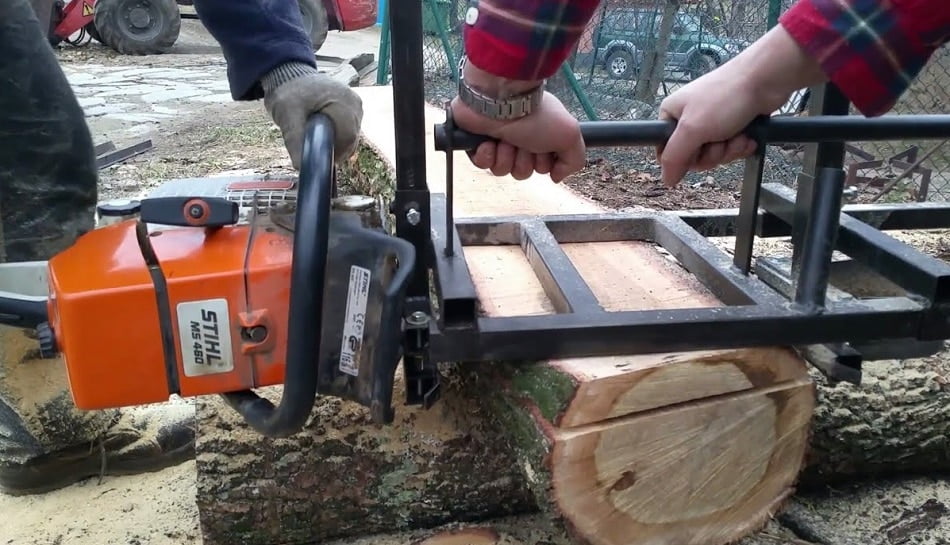Chainsaw, being one of the most familiar power tools around, comes up with a wide array of applications. And one of those uses that mostly carpenters are up to, is milling different sizes of woods or soft workpieces.
But if you are just starting to choose the right chainsaw for milling, you’ve solved the mystery of- which size of chainsaw should you pick up for your milling project?
To be straight forward, these are a number of considerable facts if we get to discuss the facts in-depth. And that’s what this entire article is written around. Keep reading-
3 Types of Chainsaw Sizes for Milling:
Before discussing the 3 types of chainsaw sizes that are often used in milling, here goes the rule of thumb of calculating the required chainsaw size for milling any particular tree branch, limb, and even stumps-
The Rule of Thumb:
First of all, measure the diameter of the tree branch. Then add 2 inches with that, you will get the required bar size of the chainsaw that you need to equip for milling that particular workpiece.
But for the sake of handling and safety, sometimes larger and smaller chainsaws are advised to use for milling.
1 of 3: Chainsaw for Non-professional, Light Use Milling
The first kind of milling chainsaw is not something that plumbers often use. Mostly, when it comes to cutting down logs(that are already cut into small pieces) into smaller pieces in a mill, this kind of chainsaw comes in use.
For this type of milling, we’re considering that you’re dealing with small tree branches or logs that are about 10-12 inches in diameter. In that case, you should pick up chainsaws of about 14 inches long cutting bar.
Here are a few facts about this particular kind of chainsaw-
- These chainsaws are the safest kind available among all of the commercial and industrial models.
- Using such chainsaws for beginners doesn’t really require too much expertise and experience.
- On an occasional basis, you can use these chainsaws for other garden and lawn maintenance tasks like pruning, resizing logs and tree limbs, etc.
- For any tree branches or limbs that are not too thick, can be easily dealt with this particular kind of chainsaw.
2 of 3: Chainsaw for Moderately Professional Milling
Up next, our concern is moderate and medium-level milling. Unlike small tree branches and thin limbs, you can cut up to 16-18 inches of tree branches under this circumstance.
In order to cut down those sizes of subjects, what the rule of thumb suggests is to use a chainsaw with a bar of 18-20 inches in length. These chainsaws are also called general-purpose chainsaw. Thick tree branches, logs, hardwood pieces, wooden blocks- these are the ideal ones that you can take care of with such chainsaws.
Here are some quick facts about this kind of chainsaws-
- There are two versions of such chainsaws- the gas-powered version and the electrically powered version.
- Upon regular use, these chainsaws require blade and chain sharpening once every couple of weeks.
- A few of the replacement chainsaw should be reserved anytime while you’re milling with this kind of chainsaw.
3 of 3: Chainsaw for Non-professional, Light Use Milling
Now, this is the kind of milling task that involves completely professional plumbers and woodworkers. Over here, you have to do frequent and sometimes continuous milling. Also, there comes not only the tree branches or limbs but also even larger and thicker pieces like the stump.
However, to deal with such large-in-size tree branches, you might need chainsaws that lie within 18-24 inches of bar size. These chainsaws are mostly designed for cutting thick tree trunks, hardwood limbs, thick branches, and processed woods.
As long as such heavy-duty chainsaws are concerned, here goes some quick facts about them-
- Saws that are larger than 20 inches(in terms of bar size), is quite hard to handle.
- You might have a quite years-long experience to get the best out of these saws.
- Maintenance and troubleshooting of these chainsaws often come to be quite expensive and require professional expertise.
- As long as you’re not a commercial plumber or woodworker, don’t invest after such models of chainsaws.
Bottom Line
If you are looking for the right size of the chainsaw that you’re going to use as a milling tool, this guide has helped you out, hopefully. In some special cases, chainsaws of up to 36 inches are used. But that’s quite occasional and rare.

